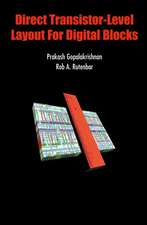Automatic Programming Applied to VLSI CAD Software: A Case Study: The Springer International Series in Engineering and Computer Science, cartea 101
Autor Dorothy E. Setliff, Rob A. Rutenbaren Limba Engleză Hardback – 31 mai 1990
| Toate formatele și edițiile | Preț | Express |
|---|---|---|
| Paperback (1) | 942.76 lei 6-8 săpt. | |
| Springer Us – 26 sep 2011 | 942.76 lei 6-8 săpt. | |
| Hardback (1) | 948.79 lei 6-8 săpt. | |
| Springer Us – 31 mai 1990 | 948.79 lei 6-8 săpt. |
Din seria The Springer International Series in Engineering and Computer Science
- 24%
 Preț: 1041.97 lei
Preț: 1041.97 lei - 20%
 Preț: 643.50 lei
Preț: 643.50 lei - 18%
 Preț: 1225.62 lei
Preț: 1225.62 lei - 18%
 Preț: 965.02 lei
Preț: 965.02 lei - 20%
 Preț: 646.12 lei
Preț: 646.12 lei - 20%
 Preț: 646.62 lei
Preț: 646.62 lei - 15%
 Preț: 637.46 lei
Preț: 637.46 lei - 20%
 Preț: 643.83 lei
Preț: 643.83 lei - 18%
 Preț: 949.23 lei
Preț: 949.23 lei - 20%
 Preț: 644.48 lei
Preț: 644.48 lei - 20%
 Preț: 994.92 lei
Preț: 994.92 lei - 20%
 Preț: 645.97 lei
Preț: 645.97 lei - 18%
 Preț: 946.87 lei
Preț: 946.87 lei - 20%
 Preț: 995.57 lei
Preț: 995.57 lei - 18%
 Preț: 956.99 lei
Preț: 956.99 lei - 20%
 Preț: 644.98 lei
Preț: 644.98 lei - 15%
 Preț: 649.54 lei
Preț: 649.54 lei - 18%
 Preț: 950.21 lei
Preț: 950.21 lei - 18%
 Preț: 1221.38 lei
Preț: 1221.38 lei - 18%
 Preț: 957.62 lei
Preț: 957.62 lei - 15%
 Preț: 643.99 lei
Preț: 643.99 lei - 18%
 Preț: 948.47 lei
Preț: 948.47 lei - 18%
 Preț: 947.35 lei
Preț: 947.35 lei - 20%
 Preț: 1284.65 lei
Preț: 1284.65 lei - 20%
 Preț: 1633.95 lei
Preț: 1633.95 lei - 20%
 Preț: 1285.78 lei
Preț: 1285.78 lei
Preț: 948.79 lei
Preț vechi: 1157.06 lei
-18% Nou
Puncte Express: 1423
Preț estimativ în valută:
181.59€ • 188.85$ • 151.95£
181.59€ • 188.85$ • 151.95£
Carte tipărită la comandă
Livrare economică 15-29 martie
Preluare comenzi: 021 569.72.76
Specificații
ISBN-13: 9780792391128
ISBN-10: 0792391128
Pagini: 234
Ilustrații: XX, 234 p.
Dimensiuni: 155 x 235 x 16 mm
Greutate: 0.54 kg
Ediția:1990
Editura: Springer Us
Colecția Springer
Seria The Springer International Series in Engineering and Computer Science
Locul publicării:New York, NY, United States
ISBN-10: 0792391128
Pagini: 234
Ilustrații: XX, 234 p.
Dimensiuni: 155 x 235 x 16 mm
Greutate: 0.54 kg
Ediția:1990
Editura: Springer Us
Colecția Springer
Seria The Springer International Series in Engineering and Computer Science
Locul publicării:New York, NY, United States
Public țintă
ResearchCuprins
1. Introduction.- 1.1. The Application Domain.- 1.2. Knowledge Sources.- 1.3. Book Organization.- References.- 2. Application Domain: Routing Algorithms.- 2.1. Routing Algorithms.- 2.2. Application Domain: Maze Routers.- 2.3. Maze Router Varieties.- 2.4. Why Choose Maze Routers?.- 2.5. Chapter Summary.- References.- 3. Software Reusability.- 3.1. Composition-Based Systems.- 3.2. Generation-Based Systems.- 3.3. Chapter Summary.- References.- 4. ELF: A Program Synthesis Architecture.- 4.1. Combining Router Knowledge with Program Synthesis Knowledge.- 4.2. Algorithm Schema Representation.- 4.3. Data Structure Style Representation.- 4.4. Intermediate Representation for Synthesized Code.- 4.5. Domain Knowledge Representation Using a Rule-Based System.- 4.6. Architecture Overview.- 4.7. Architecture Overview.- 4.8. Chapter Summary.- References.- 5. The Input Stage.- 5.1. Input Stage Operation.- 5.2. Input Stage Rule Types.- 5.3. Chapter Summary.- References.- 6. The Selection Stage.- 6.1. Selection Control Module.- 6.2. The Dependency Analysis Module.- 6.3. The Data Structure Designer Module.- 6.4. The Algorithm Designer Module.- 6.5. Chapter Summary.- References.- 7. The Code Generator Stage.- 7.1. I/O Operation Synthesis.- 7.2. The Use of Router Domain Knowledge in the Transformation Process.- 7.3. Stepwise Refinement in the Transformation Process.- 7.4. Chapter Summary.- References.- 8. Implementation.- 8.1. Implementation Characteristics.- 8.2. Design History.- 8.3. Modifying ELF: Is It Really Better?.- 8.4. Issues in Debugging ELF-synthesized Code.- 8.5. Chapter Summary.- References.- 9. ELF Validation.- 9.1. Experimental Methodology.- 9.2. Gate Array Style Routers.- 9.3. Printed Circuit Board Style Router.- 9.4. Macro-Cell IC Style Router.- 9.5. Chapter Summary.- References.- 10. Conclusion.- 10.1. Summary.- 10.2. ELF: Hindsight and Evolution.- References.- Appendix I. Router Specification Manual.- I.1. Syntax Description.- I.2. Constraint Level Structure.- I.2.1. Top-Level Constraint Specifications.- I.2.2. Aigorithm Constraints.- I.2.2.1. Net_sorting.- I.2.2.2. Node_sorting.- I.2.2.3. Cost_function.- I.2.2.4. Netlist.- I.2.2.5. Output.- I.2.2.6. Expansion.- I.2.2.7. Net_composition.- I.2.2.8. Routing_composition.- I.2.3. Application Constraints.- I.2.3.1. Type.- I.2.3.2. Sub type.- I.2.3.3. Alg_type.- I.2.3.4. Number_of_nets.- I.2.3.5. Number_of_cells_per_net.- I.2.4. Fabrication Constraints.- I.2.4.1. Units.- I.2.4.2. Pads.- I.2.4.3. Connections.- I.2.4.4. Xsize, Ysize,Zsize.- I.2.4.5. Technology.- I.2.4.6. PCB.- I.2.4.7. Number_of_layers.- I.2.4.8. Available_via_positioning.- I.2.4.9. Layer.- I.2.4.10. IC.- I.3. Input constraint Schemes.

















